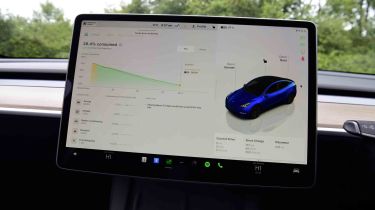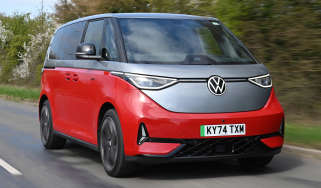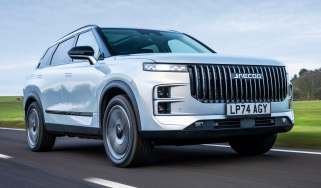Tesla Model Y - Range, charging and running costs
With a long range, efficient powertrain and the reassurance of the Supercharger network, the Tesla Model Y is an easy car to recommend

The Model Y gets a lot of the EV basics right and, while Tesla doesn’t quote official battery sizes for its cars, the pack in the Model Y is big enough to deliver a strong overall range. The best performer is the Long Range RWD, which can cover a claimed 373 miles, while adding four-wheel drive reduces this to 331 miles. The Performance model has a maximum range of 319 miles.
However, with a breadth of all-electric family cars (such as the competitively priced Peugeot E-3008 and Vauxhall Grandland Electric) now offering more than 400 miles from a single charge, you should see a slight uptick in the figures for the revised Model Y to help keep it competitive.
In our time aboard the current Model Y Long Range Rear-Wheel Drive, we averaged 3.7 miles per kilowatt hour. This figure was achieved in cool conditions and with no concessions to EV driving, so in warmer months and with a lighter foot, it could certainly be improved upon. In other words, Tesla’s claim of 4.0mi/kWh should be achievable. Cold-weather efficiency shouldn’t take too drastic a hit, however, because a heat pump is fitted as standard.
Electric range, battery life and charge time
Based on an efficiency figure of 3.7 miles per kWh, the Model Y would be capable of 340 miles on a single charge – farther than most people would drive before stopping. When the time comes to recharge, all models, including the latest Long Range Rear-Wheel Drive, are now capable of replenishing their battery at up to 250kW, which means a 0-80 per cent top-up should take around 25 minutes.
Used - available now

2023 Tesla
Model Y
30,628 milesAutomaticElectric
Cash £28,000
2023 Tesla
Model Y
24,311 milesAutomaticElectric
Cash £26,300
2023 Tesla
Model Y
35,341 milesAutomaticElectric
Cash £26,000
2023 Tesla
Model Y
12,039 milesAutomaticElectric
Cash £27,300Sign up for the Tesla Supercharger network, and you can reap the benefits of the UK’s best EV charging network. Fast chargers and smart charging tech that’s designed to optimise battery condition will help the Model Y’s battery life, and also means that you won’t be sitting around waiting for the car to be topped up for any longer than necessary.
Even better is that the system automatically debits your account, so you don’t have to faff around with card readers or anything else when you’re on the road - simply plug in and charge, and you’ll get a monthly statement showing how much you’ve used
| Model | Battery size | Range | Insurance group |
| Model Y Long Range RWD | 92kWh | 373 miles | 45 |
| Model Y Long Range AWD | 92kWh | 331 miles | 48 |
| Model Y Performance | 92kWh | 319 miles | 50 |
Tax
Being a full EV means the Model Y is currently not subject to any VED charges. But, for electric, zero or low emission cars registered on or after 1 April 2025, you will need to pay the lowest first year rate of vehicle tax set at £10 from 1 April 2025. From the second tax payment onwards, you will pay the standard rate of £195.
The financial pain doesn’t end there, however, because any electric cars registered between 1 April 2017 and 31 March 2025 will also be subject to the £195 standard rate. Plus, EVs are set to be included in the luxury car tax from April 2025, too. This means, if you own an electric car over the £40k threshold, then you could end up paying a substantial £620 per year from years two to six. Likewise, Benefit-in-Kind (BiK) tax banding is rising for EVs - up from two to three per cent for the 2025/26 tax year.
Insurance groups
The one exception to the Tesla’s low running costs comes in its insurance. Even the base model gets a lofty group 45 rating, so it’ll be very important to shop around to find the most competitive figures.
Depreciation
If you plan to hold on to your Model Y for some time – or even make the most of some competitive finance deals – then above-average residuals certainly help its cause. That desirability is reflected in the fact that after three years or 36,000 miles, it is predicted to maintain between 52 and 55 per cent of its original value (the stronger number applies to this Long Range Rear-Wheel Drive model). That compares strongly with other premium EVs such as the Audi Q4 e-tron – expected to retain just 40-43 per cent of its asking price over the same period.
To get an accurate valuation for a specific model, check out our valuation tool...










